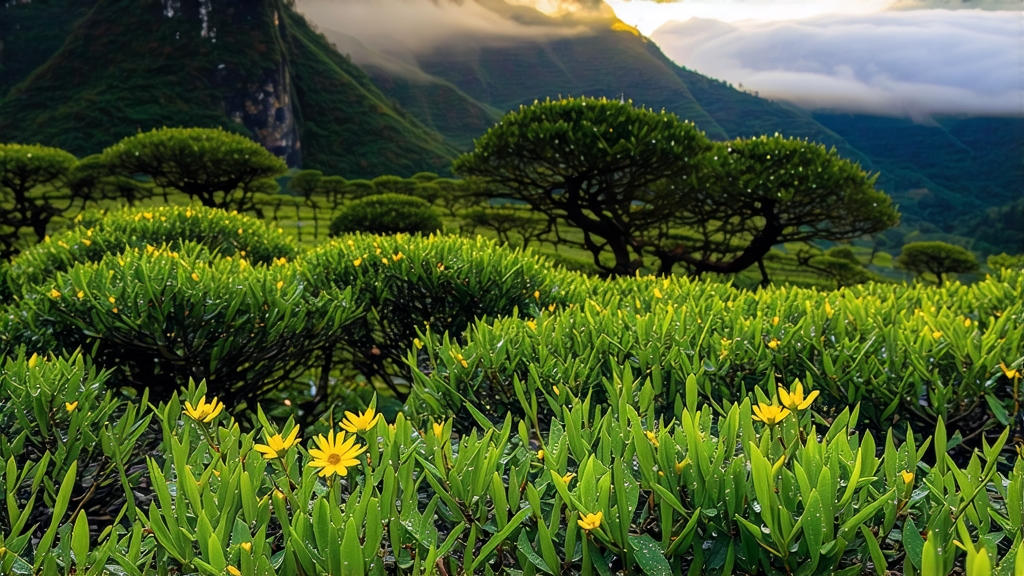
Tucked high on the northern rim of the Sichuan Basin, where the Min River cuts a gorge through 14,000-foot peaks, lies a plateau so often wrapped in cloud that Tang-dynasty poets called it “the sky’s own tea garden.” Here, on Meng Ding Mountain, Buddhist monks began cultivating a tiny, jade-yellow bud more than twelve centuries ago. That bud, Meng Ding Huang Ya—literally “Meng Ding Yellow Sprout”—is today the least-known yet most aristocratic member of China’s yellow-tea family. While dragon-well green or iron- goddess oolong travel the globe in glossy tins, Meng Ding Huang Ya still travels mainly in the memories of Sichuanese grandfathers and in the ledgers of late-dynasty emperors. This article invites the international tea lover to discover why the slow, secret “sealed yellowing” of a single mountain bud once rivalled Persian saffron in price, and how to coax its hidden honey-lotus aroma into a modern glass kettle.
-
A leaf born of mist and monastery
Meng Ding’s slopes rise through five climatic zones in only 1,300 m of elevation gain. Morning fogs linger until noon, filtering sunlight into a soft, blue-white glow that slows photosynthesis and concentrates amino acids. The local cultivar—Camellia sinensis var. sinensis ‘Meng Ding #9’—keeps its terminal bud nearly hairless, giving it a translucent, primrose hue even on the bush. Legend credits the Zen master Wu Liang with grafting wild tea onto the cliff-side terraces around 750 CE; by the Song dynasty the leaf had become so coveted that an imperial courier station was built at the mountain’s base to rush each spring’s pick to the capital within five days. -
From tribute to obscurity
During the Ming and Qing, Meng Ding Huang Ya was listed first among “the Ten Famous Teas” presented at the Palace of Heavenly Purity. Court physicians praised its “cooling” properties, while emperors rewarded generals with 50-gram sachets sealed in yellow silk—the colour reserved for royalty. When the last Qing caravan left Meng Ding in 1911, civil war and banditry severed the trade route; the yellowing technique survived only because three monk-farmers barricaded themselves in the monastery kitchen and continued to wrap tiny batches in rice paper every spring. Not until 1978 did a Sichuan agricultural institute rediscover their notes and re-establish commercial production, yet even now annual output rarely exceeds 1,200 kg. -
The alchemy of “sealed yellowing”
Yellow tea’s defining step is not pan-firing but a post-oxidative rest known as men huang—“sealed yellowing.” After picking, Meng Ding buds undergo:
a) 45-second tumble in a 90 °C bamboo roaster to kill green enzymes;
b) light rolling for 3 minutes to bruise epidermal cells;
c) wrapping in steamed linen bundles (500 g each) and stacking in a pine-wood humidor kept at 28 °C and 75 % RH for 48–72 h;
d) low charcoal bake at 55 °C to fix colour and moisture at 5 %.
During humid rest, chlorophyll degrades into pheophytin while catechins dimerise, turning the leaf a pale champagne and creating the mellow “cooked chestnut” note that distinguishes yellow from green tea. Because the bud is so small—one kilo contains 14,000 tips—any lapse in humidity collapses the cell walls, yielding a sour, olive-grey infusion. Thus each bundle is turned every four hours by a master who listens for the faint rustle that signals correct moisture migration.
- Grades and appearance
Meng Ding Huang Ya is sorted into three grades judged solely by bud integrity:
- Imperial Sparrow Tongue: single unbroken bud, 12–15 mm, downy silver tip, liquor the colour of chardonnay.
- Golden Crescent: bud plus first unfolded leaf, 20 mm, shaped like a tiny scimitar during charcoal pressing.
- Misty Pearl: bud plus two leaves, gently curled, more vegetal, meant for everyday drinking yet still subjected to full yellowing.
- Brewing the forgotten emperor’s cup
Western brewers often treat yellow tea like a delicate green, then complain of thinness. Meng